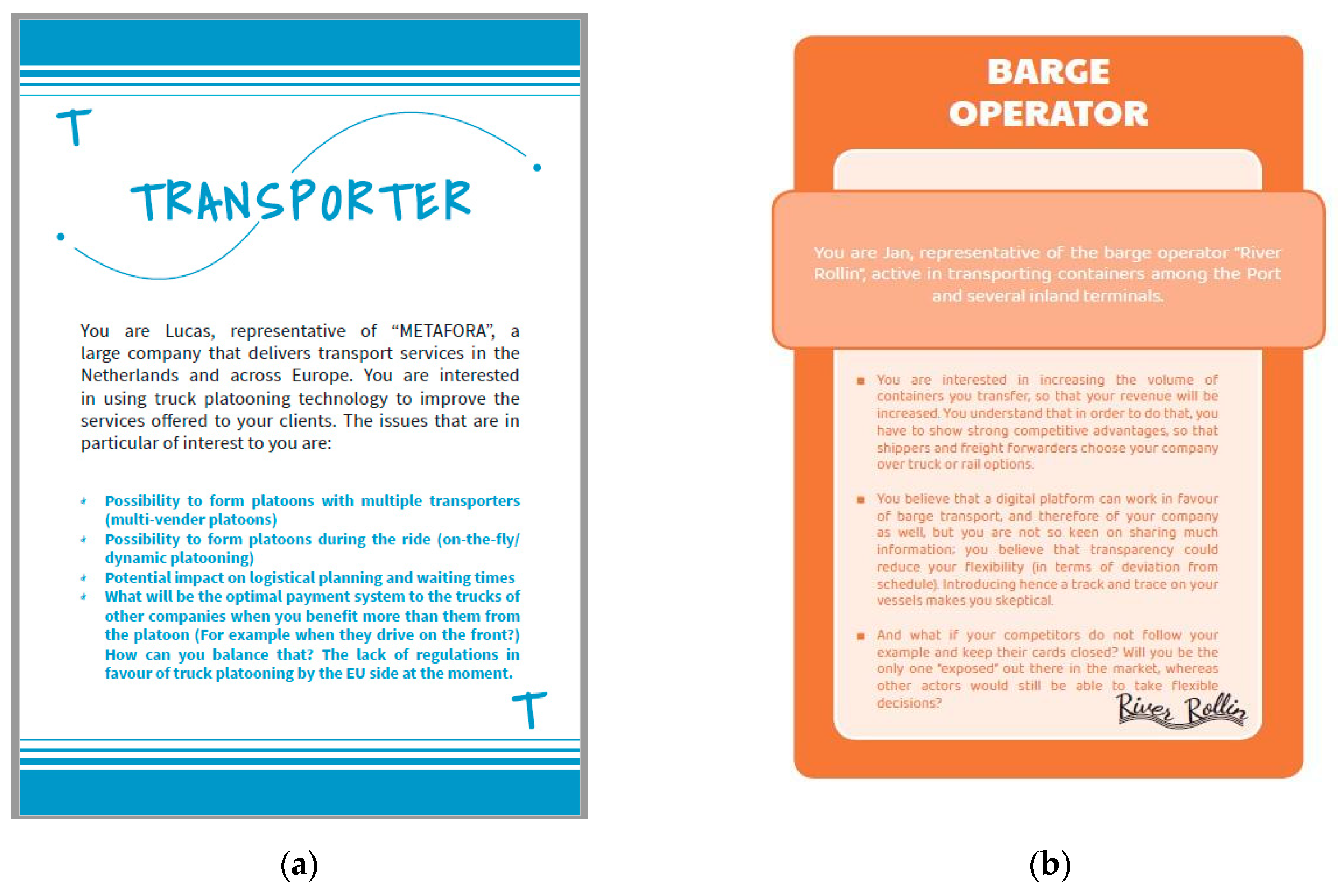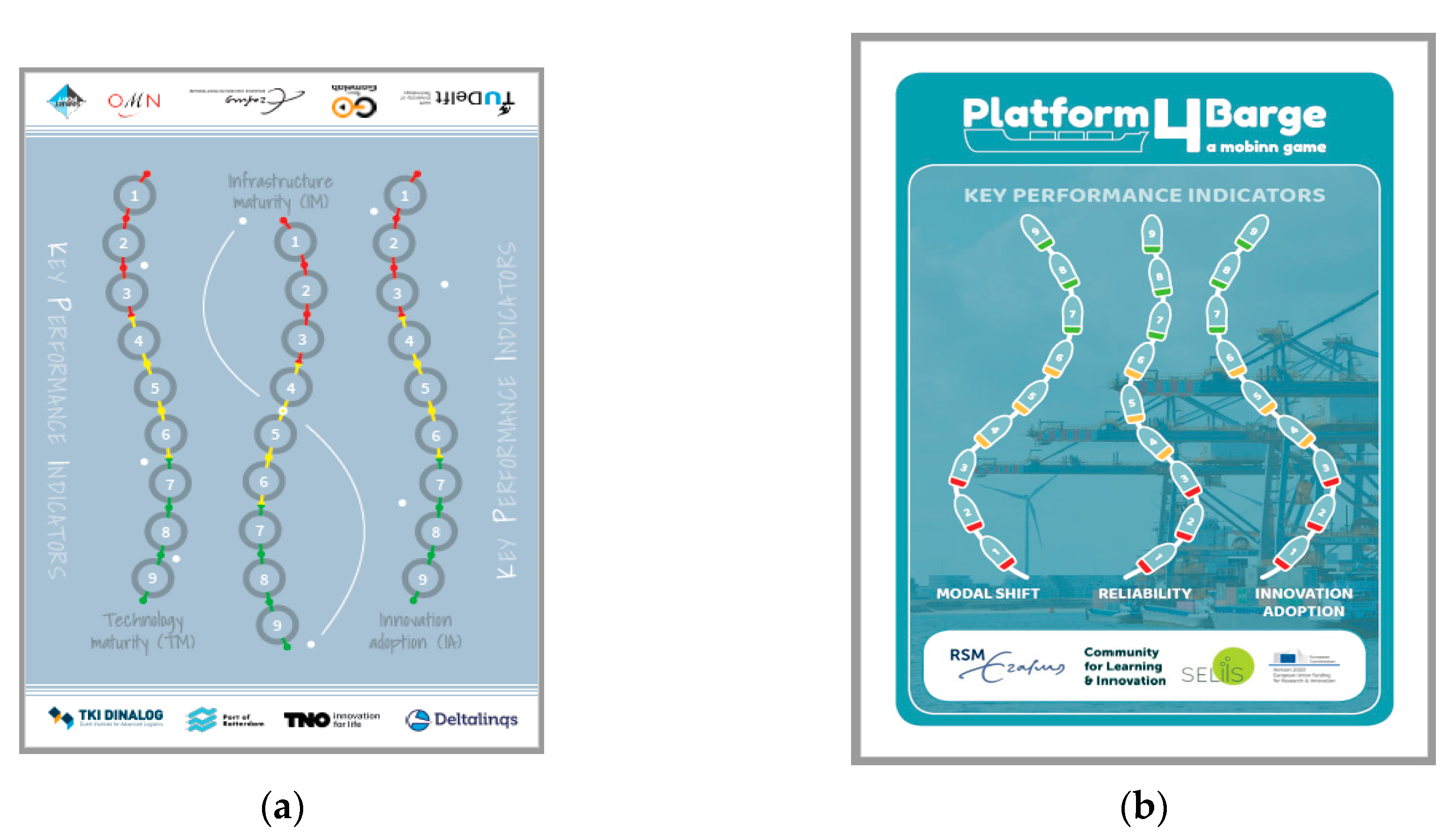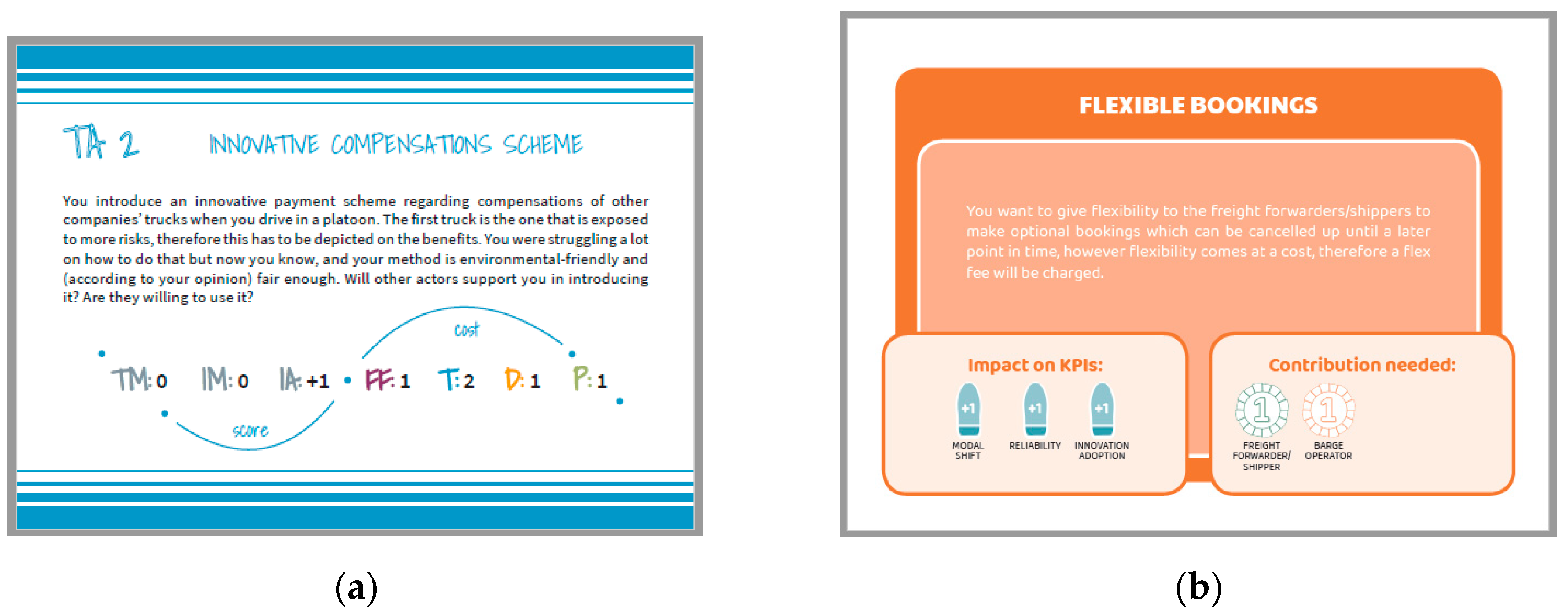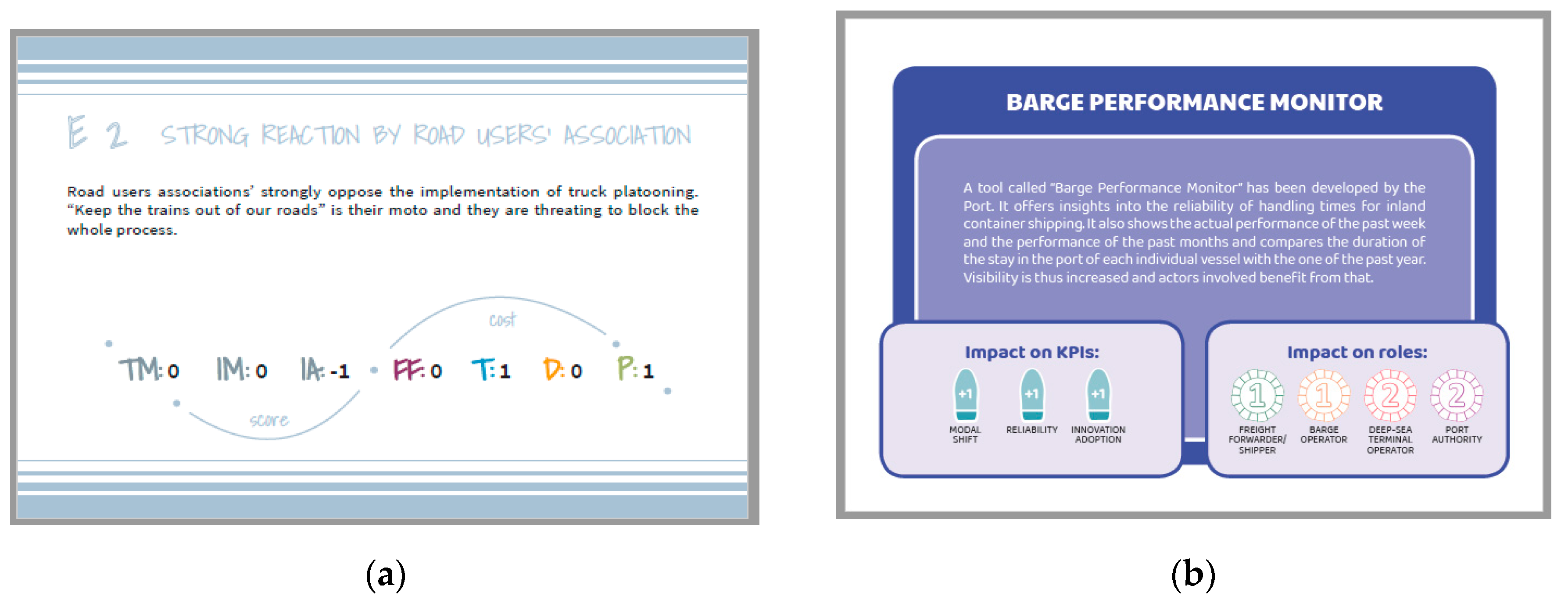Let the Game Begin: Enhancing Sustainable Collaboration among Actors in Innovation Ecosystems in a Playful Way
Abstract
1. Introduction
2. Literature Review
2.1. Overview of the Concept of Innovation Ecosystems
2.2. Overview of the Use of Games in Transport, Logistics and Innovation
- They are able to reveal mechanisms such as the initial assumptions of the stakeholders involved, their decisions, as well as the feedback loops that are created by their reactions;
- They demonstrate the effects of these mechanisms over time, which in real life becomes evident over a much longer period, and;
- They create a risk-free environment in which the representatives of the different actors can test hypothetical scenarios of different policies and experiment with new ways of interpreting these and similar actions.
3. Case Analysis—Context of the Game-Based Research Studies
4. Development of the Serious Games
4.1. Elements and Game Play
4.2. Play-Test Sessions and Data Collection
5. Results and Discussion
6. Conclusions
Author Contributions
Funding
Acknowledgments
Conflicts of Interest
References
- United Nations Department of Economic and Social Affairs. World Economic and Social Survey 2018: Frontier Technologies for Sustainable Development; United Nations Department of Economic and Social Affairs: New York, NY, USA, 2018; ISBN 9789211091793. [Google Scholar]
- Trischler, J.; Johnson, M.; Kristensson, P. A service ecosystem perspective on the diffusion of sustainability-oriented user innovations. J. Bus. Res. 2020, 116, 552–560. [Google Scholar] [CrossRef]
- Gruenhagen, J.H.; Parker, R. Factors driving or impeding the diffusion and adoption of innovation in mining: A systematic review of the literature. Resour. Policy 2020, 65, 101540. [Google Scholar] [CrossRef]
- Acciaro, M.; Sys, C. Innovation in the maritime sector: Aligning strategy with outcomes. Marit. Policy Manag. 2020, 1–19. [Google Scholar] [CrossRef]
- Nilsson, F.R. A complexity perspective on logistics management: Rethinking assumptions for the sustainability era. Int. J. Logist. Manag. 2019, 30, 681–698. [Google Scholar] [CrossRef]
- Roukouni, A.; Zuidwijk, R. Port of Rotterdam: Booking.com for Container Transport; Erasmus Research Institute of Management, RSM Case Development Centre: Rotterdam, The Netherlands, 2020; pp. 1–14. [Google Scholar]
- Liu, Z.; Stephens, V. Exploring innovation ecosystem from the perspective of sustainability: Towards a conceptual framework. J. Open Innov. Technol. Mark. Complex. 2019, 5, 48. [Google Scholar] [CrossRef]
- Bacon, E.; Williams, M.D.; Davies, G. Coopetition in innovation ecosystems: A comparative analysis of knowledge transfer configurations. J. Bus. Res. 2020, 115, 307–316. [Google Scholar] [CrossRef]
- Toshiyuki, K.; Kazuaki, K. An institutional approach to the creation of innovation ecosystems and the role of law. Penn St. JL Int’l Aff. 2015, 4, 167. [Google Scholar]
- Smorodinskaya, N.; Russell, M.; Katukov, D.; Still, K. Innovation Ecosystems vs. Innovation Systems in Terms of Collaboration and Co-creation of Value. In Proceedings of the 50th Hawaii International Conference on System Sciences, Waikoloa Village, HI, USA, 4–7 January 2017. [Google Scholar] [CrossRef]
- Agogué, M.; Levillain, K.; Hooge, S. Gamification of Creativity: Exploring the Usefulness of Serious Games for Ideation. Creat. Innov. Manag. 2015, 24, 415–429. [Google Scholar] [CrossRef]
- Raghothama, J.; Meijer, S.A. A Review of Gaming Simulation in Transportation. In Proceedings of the Frontiers in Gaming Simulation. ISAGA 2013. Lecture Notes in Computer Science; Springer: Berlin/Heidelberg, Germany, 2014. [Google Scholar]
- Midden, C.; McCalley, T.; Ham, J.; Zaalberg, R. Using persuasive technology to encourage sustainable behavior. In Proceedings of the 6th International Conference on Pervasive Computing, Workshop on Pervasive Persuasive Technology and Environmental Sustainability, Sydney, Australia, 19 May 2008; Volume 113, pp. 83–86. [Google Scholar]
- Bessant, J.; Rush, H.; Gray, W.; Hoffman, K.; Ramalingam, B.; Marshall, N. Development D. for I. Innovation Management, Innovation Ecosystems and Humanitarian Innovation; University of Brighton: Brighton, UK, 2014. [Google Scholar]
- Duncan, L. Innovation as an ongoing process: Developing creative capabilities. Strateg. Dir. 2014, 30, 13–15. [Google Scholar] [CrossRef]
- Vargo, S.L.; Akaka, M.A.; Wieland, H. Rethinking the process of diffusion in innovation: A service-ecosystems and institutional perspective. J. Bus. Res. 2020, 116, 526–534. [Google Scholar] [CrossRef]
- Corsaro, D.; Cantù, C.; Tunisini, A. Actors’ Heterogeneity in Innovation Networks. Ind. Mark. Manag. 2012, 41, 780–789. [Google Scholar] [CrossRef]
- Moore, J.F. Predators and Prey: A New Ecology of competition. Harv. Bus. Rev. 1993, 71, 75–83. [Google Scholar] [PubMed]
- Russell, M.G.; Smorodinskaya, N.V. Leveraging complexity for ecosystemic innovation. Technol. Forecast. Soc. Chang. 2018, 136, 114–131. [Google Scholar] [CrossRef]
- Katz, B.; Wagner, J. The Rise of Innovation Districts: A New Geography of Innovation in America. Harv. Bus. Rev. 2014, 1–34. Available online: https://www.brookings.edu/wp-content/uploads/2016/07/InnovationDistricts1.pdf (accessed on 25 September 2020).
- Dattee, B.; Alexy, O.; Autio, E. Maneuvering in Poor Visibility: How Firms play the ecosystem game when uncertainty is high. Acad. Manag. J. 2017, 1–67. [Google Scholar] [CrossRef]
- Mulas, V.; Minges, M.; Applebaum, H. Boosting Tech Innovation: Ecosystems in Cities. Innovations 2016, 11, 98–125. [Google Scholar] [CrossRef]
- Russell, M.G.; Huhtamäki, J.; Still, K.; Rubens, N.; Basole, R.C. Relational capital for shared vision in innovation ecosystems. Triple Helix 2015, 2. [Google Scholar] [CrossRef]
- Su, Y.S.; Zheng, Z.X.; Chen, J. A multi-platform collaboration innovation ecosystem: The case of China. Manag. Decis. 2018, 56, 125–142. [Google Scholar] [CrossRef]
- Zahra, S.A.; Nambisan, S. Entrepreneurship and strategic thinking in business ecosystems. Bus. Horiz. 2012, 55, 219–229. [Google Scholar] [CrossRef]
- de Vasconcelos Gomes, L.A.; Salerno, M.S.; Phaal, R.; Probert, D.R. How entrepreneurs manage collective uncertainties in innovation ecosystems. Technol. Forecast. Soc. Chang. 2018, 128, 164–185. [Google Scholar] [CrossRef]
- Lubik, S.; Garnsey, E. Entrepreneurial innovation in science-based firms: The need for an ecosystem perspective. In Handbook of Research on Small Business and Entrepreneurship; Chell, E., Karataş-Özkan, M., Eds.; Edward Elgar: Cheltenham, UK, 2014; pp. 599–633. [Google Scholar]
- Pellinen, A.; Ritala, P.; Järvi, K.; Sainio, L.M. Taking initiative in market creation—A business ecosystem actor perspective. Int. J. Bus. Environ. 2012, 5, 140. [Google Scholar] [CrossRef]
- Meyer-Larsen, N.; Hauge, J.; Baalsrud, M.R.; Hamadache, K.; Aifadopoulou, G.; Forcolin, M.; Roso, V.; Tsoukos, G.; Westerheim, H. Accelerating the Innovation Uptake in Logistics. In Innovative Methods in Logistics and Supply Chain Management; Blecker, T., Kersten, W., Ringle, C.M., Eds.; Epubli: Berlin, Germany, 2014; Volume 19. [Google Scholar]
- Warnke, P.; Koschatzky, K.; Som, O.; Stahlecker, T.; Nabitz, L.; Braungardt, S.; Cuhls, K.; Dönitz, E.; Güth, S.; Plötz, P.; et al. Opening Up the Innovation System Framework Towards New Actors and Institutions. Innov. Syst. Policy Anal. 2016, 49, Fraunhofer ISI, Karlsruhe. Available online: https://www.econstor.eu/handle/10419/129191 (accessed on 9 September 2020).
- Wilkinson, P. A brief history of serious games. In Entertainment Computing and Serious Games; van der Spek, E., Göbel, S., Do, E.Y.-L., Clua, E., Baalsrud, H.J., Eds.; Springer International Publishing AG: Berlin/Heidelberg, Germany, 2016; pp. 17–41. [Google Scholar]
- D’Angour, A. Plato and Play: Taking Education Seriously in Ancient Greece. Am. J. Play 2013, 5, 293–307. [Google Scholar]
- Abt, C.C. Serious Games; Viking Press: New York, NY, USA, 1970. [Google Scholar]
- Duke, R.D. Gaming: The Future’s Language; SAGE Publications Inc., John Wiley & Sons: New York, NY, USA, 1974. [Google Scholar]
- Mayer, I.S. The Gaming of Policy and the Politics of Gaming: A Review. Simul. Gaming 2009, 40, 825–862. [Google Scholar] [CrossRef]
- Lukosch, H.K.; Bekebrede, G.; Kurapati, S.; Lukosch, S.G. A Scientific Foundation of Simulation Games for the Analysis and Design of Complex Systems. Simul. Gaming 2018, 49, 279–314. [Google Scholar] [CrossRef]
- Constantinescu, T.; Devisch, O.; Huybrechts, L. Civic Participation: Serious Games and Spatial Capacity Building. In Proceedings of the MEDIA CITY 5 International Conference, Plymouth, UK, 3 May 2015; pp. 179–263. [Google Scholar]
- Olejniczak, K.; Wolański, M.; Widawski, I. Regulation crash-test: Applying serious games to policy design. Policy Des. Pract. 2018, 1, 194–214. [Google Scholar] [CrossRef]
- Patricio, R. A gamified approach for engaging teams in corporate innovation and entrepreneurship. World J. Sci. Technol. Sustain. Dev. 2017, 14, 254–262. [Google Scholar] [CrossRef]
- Oonk, M. Smart Logistics Corridors and the benefits of Intelligent Transportation Systems. I. In Towards Innovative Freight and Logistics, Science, Society and New Technologies Series, Research for Innovative Transports Set; Wiley: Hoboken, NJ, USA, 2016. [Google Scholar]
- van Pelt, S.C.; Haasnoot, M.; Arts, B.; Ludwig, F.; Swart, R.; Biesbroek, R. Communicating climate (change) uncertainties: Simulation games as boundary objects. Environ. Sci. Policy 2015, 45, 41–52. [Google Scholar] [CrossRef]
- Hidayatno, A.; Zulkarnain; Hasibuan, R.G.; Wardana Nimpuno, G.C.; Destyanto, A.R. Designing a serious simulation game as a learning media of sustainable supply chain management for biofuel production. Energy Procedia 2019, 156, 43–47. [Google Scholar] [CrossRef]
- Blöchl, S.J.; Michalicki, M.; Schneider, M. Simulation Game for Lean Leadership—Shopfloor Management Combined with Accounting for Lean. Procedia Manuf. 2017, 9, 97–105. [Google Scholar] [CrossRef]
- Van den Hoogen, J.; Meijer, S. Gaming and Simulation for Railway Innovation: A Case Study of the Dutch Railway System. Simul. Gaming 2014, 46, 489–511. [Google Scholar] [CrossRef]
- Kurapati, S.; Kourounioti, I.; Lukosch, H.; Tavasszy, L.; Verbraeck, A. Fostering sustainable transportation operations through corridor management: A simulation gaming approach. Sustainability 2018, 10, 455. [Google Scholar] [CrossRef]
- Bekebrede, G.; Lo, J.; Lukosch, H. Understanding Complex Systems Through Mental Models and Shared Experiences: A Case Study. Simul. Gaming 2015, 46, 536–562. [Google Scholar] [CrossRef]
- Witte, P.; Slack, B.; Keesman, M.; Jugie, J.H.; Wiegmans, B. Facilitating start-ups in port-city innovation ecosystems: A case study of Montreal and Rotterdam. J. Transp. Geogr. 2018, 71, 224–234. [Google Scholar] [CrossRef]
- Port of Rotterdam, Facts & Figures: A Wealth of Information. Make It Happen. Available online: https://www.portofrotterdam.com/sites/default/files/facts-and-figures-port-of-rotterdam.pdf (accessed on 25 September 2020).
- Van der Horst, M.; Kort, M.; Kuipers, B.; Geerlings, H. Coordination problems in container barging in the port of Rotterdam: An institutional analysis. Transp. Plan. Technol. 2019, 42, 187–199. [Google Scholar] [CrossRef]
- Roukouni, A.; Lukosch, H.; Verbraeck, A.; Zuidwijk, R. Mobilise Innovation (Mobinn): A playful Approach applied to the Transport and Logistics Sector. In Proceedings of the 50th ISAGA (International Simulation and Gaming Association) Conference: Simulation & Gaming through Time and across Disciplines. Past and Future, Heritage and Progress, Warsaw, Poland, 26–30 August 2019; pp. 468–479. [Google Scholar]
- Van Ark, E.J.; Duijnisveld, M.; van Eijk, E.; Janssen, R.; van Ommeren, C.; Soekroella, A. Value Case Truck Platooning—An Early Exploration of the Value of Large-Scale Deployment of Truck Platooning. TNO: Den Haag, The Netherlands, 2017, 1–100. Available online: https://repository.tudelft.nl/view/tno/uuid%3A770c9b7c-40f0-4036-93e8-caba19c2b311 (accessed on 25 September 2020).
- Deelen, C. Truck Platooning. Available online: https://smartport.nl/en/project/truck-platooning/ (accessed on 5 October 2020).
- Tavasszy, L. On the Value Case for Truck Platooning in Europe. Discussion Paper for Truck Platooning Next Level Group Meeting, a Side Event to the ITS European Congress, Glasgow, June 6, 2016. Available online: https://www.researchgate.net/publication/312116529_The_value_case_for_truck_platooning (accessed on 9 September 2020).
- Bakermans, B.A. Truck Platooning Enablers, Barriers, Potential and Impacts; TU Delft: Delft, The Netherlands, 2016. [Google Scholar]
- Roukouni, A.; Lukosch, H.; Verbraeck, A. Simulation games to foster innovation: Insights from the transport and logistics sector. In Neo-Simulation and Gaming Toward Active Learning, Translational Systems Sciences; Hamada, R., Soranastaporn, S., Kanegae, H., Dumrongrojwatthana, P., Chaisanit, S., Rizzi, P., Dumblekar, V., Eds.; Springer: Singapore, 2019; pp. 157–165. [Google Scholar]
- Hagiu, A.; Wright, J. Multi-Sided Platforms. Int. J. Ind. Organ. 2015, 43, 162–174. [Google Scholar] [CrossRef]
- Van Alstyne, M.W.; Parker, G.G.; Choudary, S.P. Pipelines, Platforms, and the New Rules of Strategy. Harv. Bus. Rev. 2016, 94, 54–62. [Google Scholar]
- Evans, D.S.; Schmalensee, R. The Antitrust Analysis of Multi-Sided Platform Businesses; National Bureau of Economic Research: Cambridge, MA, USA, 2013. [Google Scholar]
- SELIS. Deliverable D7.21, Living Labs Operation Learning Conclusions and Other SELIS Value Propositions, Final Version; SELIS, 2019; Available online: https://www.selisproject.eu/uploadfiles/D-721-delLL_Operation_Learning_Conclusions_v3.0.pdf (accessed on 9 September 2020).
- Christopher, M.; Lee, H. Mitigating supply chain risk through improved confidence. Int. J. Phys. Distrib. Logist. Manag. 2004, 34, 388–396. [Google Scholar] [CrossRef]
- Olesen, P.B.; Hvolby, H.H. D-PI Enabling Information Sharing in a Port. In Proceedings of the Dvances in Production Management Systems. Competitive Manufacturing for Innovative Products and Services. APMS 2012. IFIP Advances in Information and Communication Technology; Emmanouilidis, C., Taisch, M., Kiritsis, D., Eds.; Springer: Berlin/Heidelberg, Germany, 2013; pp. 152–159. [Google Scholar]
- Macharis, C. Mobility is a serious game: A game to explore the future of mobility. In Proceedings of the Transportation Research Board 97th Annual Meeting, Washington, DC, USA, 7–11 January 2018. [Google Scholar]
- König, A.; Kowala, N.; Wegener, J.; Grippenkoven, J. Introducing a mobility on demand system to prospective users with the help of a serious game. Transp. Res. Interdiscip. Perspect. 2019, 3, 100079. [Google Scholar] [CrossRef]
- Harteveld, C. Triadic Game Design: Balancing Reality, Meaning and Play, 1st ed.; Springer: London, UK, 2011; ISBN 978-1-84996-157-8. [Google Scholar]
- Bhoopalam, A.K.; Agatz, N.; Zuidwijk, R. Planning of truck platoons: A literature review and directions for future research. Transp. Res. Part B 2018, 107, 212–228. [Google Scholar] [CrossRef]
- Janssen, G.; Zwijnenberg, H.; Blankers, I.; de Kruijff, J. Future of Transportation Truck Platooning; TNO: Delft, The Netherlands, 2015; pp. 1–36. [Google Scholar]
- Commendatore, C. For Truck Platooning to Work, Here’s What has to Happen. FleetOwner. 2018. Available online: https://www.fleetowner.com/technology/article/21702545/for-truck-platooning-to-work-heres-what-has-to-happen (accessed on 25 September 2020).
- Malcolm Wheatley, M.R. Time to Fall in Line. Available online: https://www.automotivelogistics.media/time-to-fall-in-line/21089.article (accessed on 5 October 2020).
- Dutch Ministry of Infrastructure and Environment. European Truck Platooning Challenge 2016—A Fresh Perspective on Mobility and Logistics. 2016, 1–50. Available online: https://www.government.nl/documents/leaflets/2015/10/06/leaflet-european-truck-platooning-challenge-2016 (accessed on 9 September 2020).
- Association, E.A.M. First Cross-Border Truck Platooning Trial Successfully Completed. Available online: https://www.acea.be/press-releases/article/first-cross-border-truck-platooning-trial-successfully-completed (accessed on 5 October 2020).
- Roberts, J. Success of Truck Platooning Challenge Clears Way for Real-Life Convoys—Steve Phillips, CEDR. Available online: https://horizon-magazine.eu/article/success-truck-platooning-challenge-clears-way-real-life-convoys-steve-phillips-cedr.html (accessed on 5 October 2020).
- Anastasia, R.; Rob, Z. Multi-Sided Platforms in Europe’s Logistics Sector; RSM Case Development Centre: Rotterdam, The Netherlands, 2020. [Google Scholar]
- OECD Glossary. Available online: https://stats.oecd.org/glossary/detail.asp?ID=4313 (accessed on 9 September 2020).
- Kriz, W.C. A systemic-constructivist approach to the facilitation and debriefing of simulations and games. Simul. Gaming 2010, 41, 663–680. [Google Scholar] [CrossRef]
- SmartPort About SmartPort. Available online: https://smart-port.nl/en/about-smartport-2/ (accessed on 9 September 2020).
- Erasmus, U. Erasmus Port Campus. Available online: https://www.eur.nl/en/upt/news/first-erasmus-port-campus-launches-focus-digitization-ports (accessed on 9 September 2020).
- Den Haan, R.J.; van der Voort, M.C. On evaluating social learning outcomes of serious games to collaboratively address sustainability problems: A literature review. Sustainability 2018, 10, 4529. [Google Scholar] [CrossRef]





| Mobinn | Platform4Barge |
|---|---|
| Technology maturity | Modal shift |
| Physical/legal infrastructure maturity | Reliability |
| Innovation adoption | Innovation adoption |
| Game Session | Number of Players | Type of Players | Location |
|---|---|---|---|
| 1 | 5 | Experts and actors related to the truck platooning community | Futureland, Maasvlakte II, Port of Rotterdam, NL |
| 2 | 8 | Transport and logistics experts from academia and industry | SmartPort (SmartPort is “a neutral knowledge platform, stimulating alliances, financing scientific research and providing public knowledge dissemination. The aim is to speed up innovations in the Port of Rotterdam” [75] premises, Rotterdam, NL. |
| 3 | 4 | Researchers in the field of gaming and/or transportation | TPM Faculty, TU Delft, NL |
| 4 | 12 | MBA program students | Supply Chain Management Center, Robert H. Smith School of Business, USA |
| 5 | 11 | Experts in transport and logistics from the Dutch Railways | Railcenter, Amersfoort, NL |
| 6 | 5 | Actors in the field of transport and logistics | RDM Rotterdam Campus, NL |
| Game Session | Number of Players | Type of Players | Location |
|---|---|---|---|
| 1 | 4 | Experts from the Rotterdam School of Management community | Erasmus Centre for Urban, Port and Transport Economics, NL |
| 2 | 8 | Participants of Erasmus Port Campus (Erasmus Port Campus is “an initiative aiming to bring the port to the campus. The event was organized by Erasmus UPT and SmartPort@Erasmus to connect the academic world with the latest developments in the port. Theme of the day was: Digitization in ports; Lifting smart logistics to a higher level” [76], students/alumni and professionals/experts) | Erasmus Centre of Entrepreneurship, NL |
| 3 | 7 | Actors/experts working at the Port of Rotterdam on key positions | World Port Center, Port Authority of Rotterdam, NL |
Publisher’s Note: MDPI stays neutral with regard to jurisdictional claims in published maps and institutional affiliations. |
© 2020 by the authors. Licensee MDPI, Basel, Switzerland. This article is an open access article distributed under the terms and conditions of the Creative Commons Attribution (CC BY) license (http://creativecommons.org/licenses/by/4.0/).
Share and Cite
Roukouni, A.; Lukosch, H.; Verbraeck, A.; Zuidwijk, R. Let the Game Begin: Enhancing Sustainable Collaboration among Actors in Innovation Ecosystems in a Playful Way. Sustainability 2020, 12, 8494. https://doi.org/10.3390/su12208494
Roukouni A, Lukosch H, Verbraeck A, Zuidwijk R. Let the Game Begin: Enhancing Sustainable Collaboration among Actors in Innovation Ecosystems in a Playful Way. Sustainability. 2020; 12(20):8494. https://doi.org/10.3390/su12208494
Chicago/Turabian StyleRoukouni, Anastasia, Heide Lukosch, Alexander Verbraeck, and Rob Zuidwijk. 2020. "Let the Game Begin: Enhancing Sustainable Collaboration among Actors in Innovation Ecosystems in a Playful Way" Sustainability 12, no. 20: 8494. https://doi.org/10.3390/su12208494
APA StyleRoukouni, A., Lukosch, H., Verbraeck, A., & Zuidwijk, R. (2020). Let the Game Begin: Enhancing Sustainable Collaboration among Actors in Innovation Ecosystems in a Playful Way. Sustainability, 12(20), 8494. https://doi.org/10.3390/su12208494






